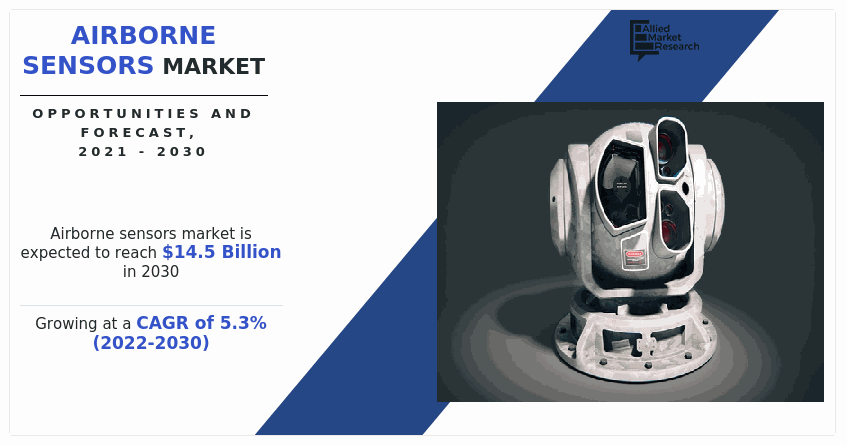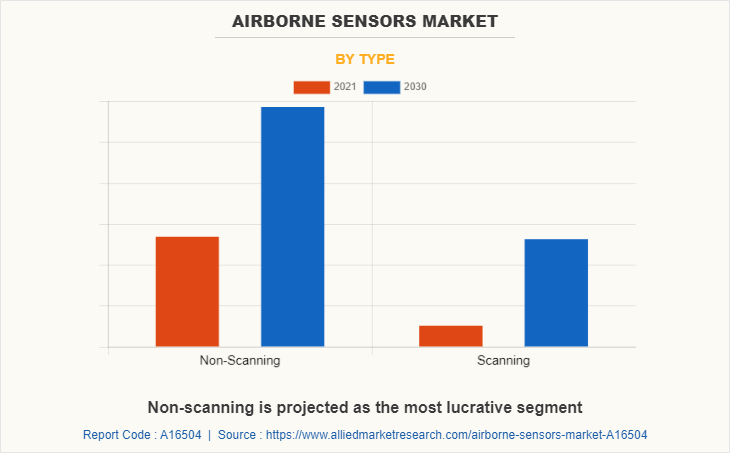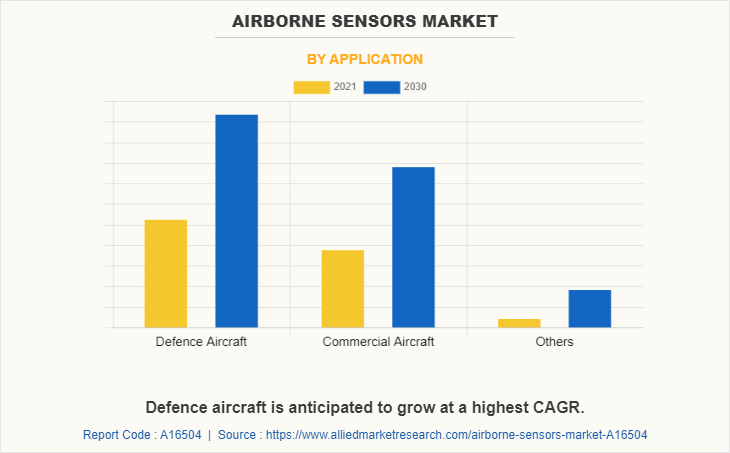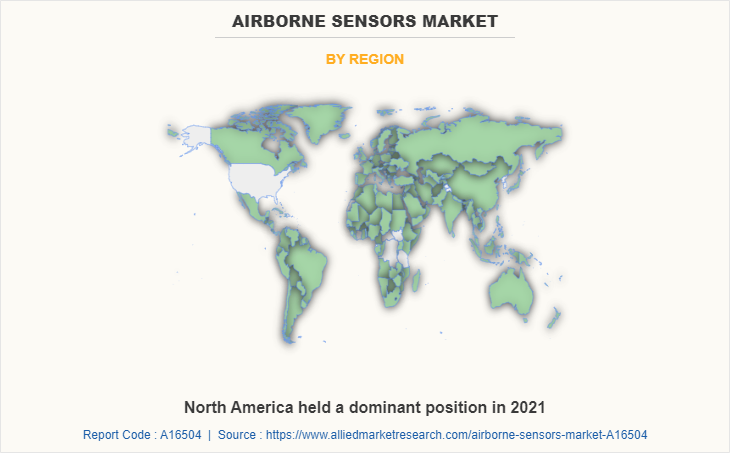Airborne Sensors Market Research, 2030
The global airborne sensors market was valued at $9.2 billion in 2021, and is projected to reach $14.5 billion by 2030, growing at a CAGR of 5.3% from 2022 to 2030.

Airborne sensors are those that are mounted on aircrafts and used to capture images of the Earth's surface. These sensors have a wide range of applications, including defense, agriculture, forestry, the environment, mining, mapping & surveying, infrastructure & urbanization, and many others. Furthermore, images with a spatial resolution of 20 cm or less can be obtained using airborne sensors. Airborne sensors are used in planes, UAS (Unmanned Aerial Systems), helicopters, high-altitude aircraft, and free-floating balloons.
The enormous growth of the global airborne sensors market is primarily attributed to rising international terrorism threats. Furthermore, rising defense & military budgets to ensure national security in both developing and developed countries are expected to accelerate demand for advanced airborne sensor solutions, potentially boosting market growth in the coming years.
The global airborne sensor industry is expanding rapidly as a result of technological advancements and increased R&D investment. Thales Group, for example, announced the launch of I-Master, an airborne surveillance radar, in August 2020. The radar has a ground and maritime moving target indication mode that can track vehicles as they move from land to sea. As a result, it is the ideal type of surveillance in coastal areas. In the coming years, this type of product development and innovation could provide lucrative opportunities for the global airborne sensors market.
The global airborne sensors market is segmented on the basis of type, application, and region. By type, the market has been divided into non-scanning and scanning airborne sensors. By application, the analysis has been divided into defense aircraft, commercial aircraft, and others. By region, the market is analyzed across North America, Europe, Asia-Pacific, and LAMEA.
The key players profiled in this report include HEXAGON, Thales Group, Raytheon Technologies, Lockheed Martin Corporation, Information Systems Laboratories (ISL), Teledyne Optech, General Dynamics Corporation, Honeywell International Inc., ITT INC. and AVT Airborne Sensing GmbH.
The airborne sensors market is segmented into Type and Application.

By type, the market has been divided into non-scanning and scanning. Non-scanning sub-segment accounted for the highest revenue share in 2021. Non-scanning airborne sensors are passive sensors, and an aerial survey camera, such as the Russian COSMOS satellite, is an example of a non-scanning airborne sensor. Furthermore, non-scanning airborne sensors can collect target data information through vibration, heat, radiation, or other signal-transmitting phenomena. There are numerous companies operating in the field of airborne sensors all over the world.

By application, the defense aircraft sub-segment accounted for the highest revenue share in 2021. The growth is subjected to key market players that are emerging in the aviation industry and are following new strategies to manufacture airborne sensors for defense use. Moreover, increasing budget of defense & military sector by government has also increased the utilization for airborne sensors in the defense sector.

By region, Europe is forecasted to be the dominant region during the forecast period. Airborne sensors have grown in importance in European countries such as Spain, the United Kingdom, Luxembourg, and Denmark. The growing use of fixed-wing aircrafts for air travel will propel the European airborne sensors market forward. Furthermore, European airborne sensor providers are pursuing strategic collaborations in order to drive novel technological innovation and gain a dominant market position. For example, TE Connectivity Ltd, Switzerland, announced the acquisition of 78% of the shares of First Sensor AG, the world's largest sensor supplier, in March 2020. As a result, there will be a wider range of products and innovative sensors available.
IMPACT OF COVID-19 ON THE GLOBAL AIRBORNE SENSORS MARKET
- The global market for airborne sensor is expected to experience a slow growth during the pandemic. The Covid-19 pandemic affected all the industries in different ways by affecting supplies, production, demands and ongoing projects in the industry.
- Furthermore, several industry players are working towards introduction of new products and adopting innovative strategies to minimize the effect of the pandemic on their business. On the other hand, some of the key airborne sensor providers like Honeywell International Inc., are following various strategies such as being fully operational during the COVID-19 pandemic.
Key Benefits For Stakeholders
- This report provides a quantitative analysis of the market segments, current trends, estimations, and dynamics of the airborne sensors market analysis from 2021 to 2030 to identify the prevailing airborne sensors market opportunities.
- The market research is offered along with information related to key drivers, restraints, and opportunities.
- Porter's five forces analysis highlights the potency of buyers and suppliers to enable stakeholders make profit-oriented business decisions and strengthen their supplier-buyer network.
- In-depth analysis of the airborne sensors market segmentation assists to determine the prevailing market opportunities.
- Major countries in each region are mapped according to their revenue contribution to the global market.
- Market player positioning facilitates benchmarking and provides a clear understanding of the present position of the market players.
- The report includes the analysis of the regional as well as global airborne sensors market trends, key players, market segments, application areas, and market growth strategies.
Airborne Sensors Market Report Highlights
| Aspects | Details |
| By Type |
|
| By Application |
|
| By Region |
|
| Key Market Players | Honeywell International Inc., Lockheed Martin Corporation, teledyne optech, information systems laboratories, ITT Inc., Thales Group, Hexagon, AVT Airborne Sensing GmbH, General Dynamics Corporation, Raytheon Technologies |
Analyst Review
Rising terrorism across the world especially in countries such as China, India, and the U.S. is proliferating the investment on the defense budget. For instance, according to the estimations of the Stockholm International Peace Research Institute (SIPRI) in 2019, the U.S has increased investment on the defense sector by approximately 6.6%, and China’s investment also surged by 6.6% as compared with 2018. Such factors are expected to increase the demand for innovative solutions such as airborne sensors. According to the analysts, Asia-Pacific is projected to register faster growth as compared to North American and European markets.
The enormous growth of the global airborne sensor market is primarily attributed to rising international terrorism threats. Furthermore, rising defense and military budgets to ensure national security in both developing and developed countries are expected to accelerate demand for advanced airborne sensor solutions, potentially boosting market growth in the coming years.
Agreement, business expansion, and product launch are the key growth strategies of global airborne sensors market players.
HEXAGON, Thales Group, Raytheon Technologies, Lockheed Martin Corporation, Information Systems Laboratories (ISL), Teledyne Optech, General Dynamics Corporation, Honeywell International Inc., ITT INC. and AVT Airborne Sensing GmbH are the leading market players active in the airborne sensors market.
Defence aircraft sub-segment held the maximum share of the global airborne sensors market in 2021
Airborne sensors capture wide terrains like forests, cities, farmlands, long power lines, rivers, and railway tracks. The sensors are capable of surveying several square kilometers in a single flight and also cover inaccessible areas. One of the perfect examples of mapping & survey would be the spotting of 138 geophysical anomalies at Dotted Lake Property, Ontario, Canada. This finding is based on the survey received by Panther Metals PLC, an exploration company. In December 2020, Prospectair Geosurveys, a Canadian airborne geophysics survey company, carried out seven flights by using a helicopter-mounted with sensors that flew the 818 line-kilometer surveys. This finding is truly remarkable and can bring massive opportunities in the coming years.
Airborne sensor industry has been proliferating their reach in multiple application areas such as in commercial sectors, construction, mining, power supply, and agriculture for monitoring the crops, pipeline, power line mapping, and geographical survey. Moreover, key and innovative market players in the airborne sensor market are following various effective strategies in order to grow in the international market. The growing demand for airborne sensors in various industrial sectors will drive the airborne sensors market forward.
Defence aircraft, commercial aircraft and others include the major customers of global airborne sensors market.
Asia-Pacific will provide more business opportunities for global airborne sensors market in the future.
The report provides an extensive qualitative and quantitative analysis of the current trends and future estimations of the global airborne sensors market from 2021 to 2030 to determine the prevailing opportunities.
Loading Table Of Content...


